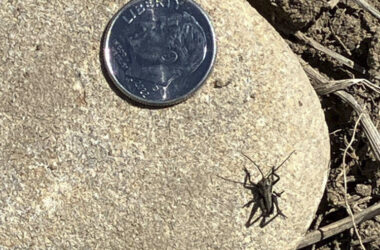RBC I Why are we drawn to monuments that commemorate evil, darkness and death? What compels us to remember things we would rather forget? Every year, thousands of visitors journey to Nazi concentration camps. Here in the U.S., President John F. Kennedy’s birthplace is a national historic site, but the museum on the sixth floor of the Dallas book depository, from which JFK’s assassin fired the deadly bullet, is arguably more popular.
Perhaps we seek out these places to remind ourselves of the depths to which we can sink and to give us the will to resist those darker impulses. Maybe it’s a kind of collective therapy: By facing our demons, we can begin to purge them.
A handful of “dark” sites are scattered across the West, and the National Park Service is adding more to its roster of historic places. The park system now includes not just Mesa Verde National Park, but also the Japanese American interment camps and Sand Creek Massacre site; not just monuments to vanished civilizations, but also reminders of bloody savagery. The Manhattan Project sites in Hanford and Los Alamos somehow manage to be shrines to both human ingenuity and barbarity.
“Our job is to help tell the full story of America—the giant jigsaw puzzle that is the United States and the American experience,” says John Sprinkle, acting chief historian for the National Park Service. That story is unavoidably complex. “You can’t just have happy history.”
The sinister chapters of our past, Sprinkle adds, offer lessons in survival, and maybe that’s part of what motivates us to engage with them.
“Folks in the past had it tough and faced adversity and came through and survived. In darkness, there can be hope.
Here, we visit three “dark parks.”—Jonathan Thompson
BAINBRIDGE ISLAND
JAPANESE/AMERICAN
EXCLUSION MEMORIAL
When the Bainbridge Island Japanese American Exclusion Memorial was little more than a clearing in a forest on Puget Sound, among its first visitors was a cacophonous murder of crows. On March 30, 2002, about 750 people came to mark the 60th anniversary of the first forced removal of Japanese Americans from the West Coast after the attack on Pearl Harbor. By shining a light on this dark piece of American history, the memorial was meant to discourage racially fueled hysteria.
Bainbridge Islanders of Japanese descent were taken primarily to the Minidoka camp in Idaho, now a National Park Service unit that includes the Bainbridge memorial. That day in 2002, their names would be read aloud as part of the dedication of a small granite marker.
The crows arrived swiftly and noisily when Clarence Moriwaki, one of the memorial’s organizers, spoke the first names. The cawing was so uproarious that some people no longer could hear Moriwaki, despite the sound system. Moriwaki worried about the moment of silence scheduled to follow.
But as soon as he uttered the last name, the crows, which the region’s Native peoples consider the spirits of their ancestors, flew off. A hush reclaimed the forest. “It was as if a switch went off,” Moriwaki recalled.
Moriwaki recounted this tale on a chilly evening last December as we waited for a vigil to begin at the memorial.
“I am Japanese American but have no direct connection with the prison camps; my mother was in Japan during the war. Yet I still feel strongly attached to that history, such a central part of my racial heritage, and have visited the memorial several times.”
The place holds a jarring grace, its beauty and serenity seeming incongruous with the history of hatred it records. The centerpiece is a 276-foot story wall, one foot for each Japanese American exiled from Bainbridge Island. It is made of old-growth red cedar and bordered by wetlands and cherry trees. The names of the exiled are affixed to the wall. It doesn’t scream the intended message: “Nidoto Nai Yoni”—let it not happen again. Not the way a bit of razor wire might.
I confessed my misgivings to Moriwaki, who reacted with unexpected delight. There already was too much ugliness and pain associated with the forced removals, he said. The organizers sought a site for healing, honor and hope as well as history. The Japanese “less-is-more” aesthetic was a testimony to the exiled, who had been burdened by shame. They approached this part of their past according to the Buddhist notion of “Gaman”—enduring the seemingly unbearable with patience and dignity. This place offered a release.
Below us in the candlelit night, people assembled at the base of the wall to protest recent anti-Muslim rhetoric from Donald Trump’s presidential campaign. It struck a chord on Bainbridge Island: More Japanese Americans returned there after World War II than to any other place in the U.S. On Bainbridge, they were embraced by neighbors, who looked after their property and possessions, fought against the mass incarceration and, in some cases, even made mortgage payments for the imprisoned. The memorial is as much a monument to those relationships as it is a warning against racial hatred. As Moriwaki put it, they “demonstrated the best of what America can be.” —Glenn Nelson
IF YOU GO: Minidoka National Historic Site, Jerome, Idaho, or Bainbridge Island Japanese American Exclusion Memorial, Bainbridge Island, Wash. 208-933-4100
SAND CREEK MASSACRE
NATIONAL HISTORIC SITE
I stood on a bluff in southeastern Colorado, overlooking the lonesome prairie 180 miles southeast of Denver. Bare cottonwoods lined the dry bed of Big Sandy Creek. Otherwise, there was nothing but grass, earth, rocks and sky. The only sounds that November day were the wind and the singing of LaForce “Lee” Lonely Bear, a Northern Cheyenne spiritual adviser.
This was the site of the notorious Sand Creek Massacre. At dawn on Nov. 29, 1864, a 675-man Colorado militia, led by Col. John Chivington, a Methodist minister, attacked a small, peaceful village of Cheyenne and Arapaho camped along the creek. Without provocation, the militia charged and killed at least 150 Indians, mostly women and children. According to militiamen and survivors, soldiers chased unarmed Indians down the creek bed, raped and bayoneted women, hacked off limbs and genitals. Cheyenne Chief White Antelope was scalped and mutilated as he pleaded for peace. The Cheyenne say that White Antelope repeated his final journey song as he lay dying: “All my relations, remember / Only the rocks on earth stay forever.”
This horrific massacre—denounced as a “cowardly and cold-blooded slaughter” by an 1867 U.S. Army inquiry—escalated simmering conflicts between Plains tribes and settlers. The fighting climaxed with the 1876 Battle of the Little Bighorn and the annihilation of Custer’s troops by the Sioux and Cheyenne. But it didn’t end until 1890, when every Plains tribe had been ushered onto a reservation.
While the massacre never entirely faded from memory, it was rarely mentioned in history books and only whispered about by tribes. Little Bighorn became a national park; Sand Creek became private ranchlands. Otto Braided Hair, a Northern Cheyenne, says he never learned about Sand Creek in school.
Braided Hair, Lone Bear and the others who brought me to the site in 2005 had been working to change that, partly by establishing Sand Creek as a national historic site managed by the National Park Service. Along with other Cheyenne and Arapaho tribes, they envisioned it becoming a place of remembrance and healing for their own people and the nation.
“So the history may live on,” Lone Bear told me.
That November afternoon, the five Northern Cheyennes had journeyed there from Montana to repatriate the remains of an ancestor who died there. As Lone Bear’s prayer carried across the plains, I realized I was experiencing a doubly rare moment. I was afield with Native Americans during a sacred rite at a sacred place, and also glimpsing a national park site to-be. After Lone Bear concluded his song, I followed him and the others down a bluff and through the grove of wrinkled cottonwoods. Braided Hair told me that they wanted the park to be simple, with a few short trails and limited services; they didn’t want visitors wandering around the lowlands and creek where the massacre actually occurred. That, the tribes believe, is consecrated land.
In 2000, the project received congressional authorization and the NPS began acquiring privately owned ranchlands encompassing the site. The Sand Creek Massacre National Historic Site was officially designated in April 2007, two years after my visit. Since then, a modest number of tourists have trickled through. And every year in November, the Cheyenne and Arapaho organize a healing run from Sand Creek to Denver, to help commemorate the massacre, the tribes and their way of life.
“Part of the reason for establishing Sand Creek as a national historic site,” Superintendent Alexa Roberts told me, “is to use it as a vehicle to recognize and help prevent such incidents from ever occurring again.” As Lone Bear and his friends had hoped, the exhibits and services today remain minimal. The primary visitors center is in the nearby town of Eads, so that at the site, “the landscape can speak for itself,” Roberts said.
It’s still possible to stand on the bluff above the creek bed and gaze across the empty, rolling prairie, imagining scenes of 19th century tribal life, and then to picture the terrifying chaos that erupted on a frozen November morning. North of the site, there’s a speck of a town called Chivington, named after the colonel who led the attack. Now, the Sand Creek Massacre appears on maps, too. But only the rocks stay forever.—Joshua Zaffos
IF YOU GO: Sand Creek Massacre National Historic Site, Eads, Colo.
MANHATTAN PROJECT
NATIONAL HISTORIC PARK
Past the gates to the Hanford Site, eastern Washington’s plains seem to sprawl forever. In 1943, seeking a site to produce plutonium for the top-secret Manhattan Project, which would yield the atomic bomb, the federal government settled on Hanford. It seemed ideal—essentially empty, an immense, remote expanse of channeled scablands inside a curve of the clear, cold Columbia River.
Hanford displaced three farming towns, whose ruins still stand, interspersed with the remains of the infrastructure needed for the world’s first full-scale nuclear reactors. The construction camp became the state’s fourth-biggest city; its 51,000 workers devoured 7,200 pies at Christmas. At its height, the 640-square-mile site was home to 544 buildings.
The B Reactor, the first to be operational, and the only one you can visit, is a blocky concrete layer cake of a building. Inside, a cavernous room holds the three-story tall reactor, its face a grid of 2,004 tubes where scientists enriched uranium into plutonium 239. One ton made a hockey puck-sized piece of plutonium.
By the late ’80s, plutonium production had ceased, and in 1989, the U.S. Department of Energy, which runs the site, demolished most of the buildings and cocooned the reactors. The nuclear waste cleanup continues, costing $2 billion a year.
In 2009, former workers asked the Department of Energy to start giving tours of the B Reactor.
“People can’t understand the impressiveness of this,” says Kevin Haggerty, the reactor’s facilities manager, noting the astonishing speed with which the power of fission was discovered and exploited. “It changed the way countries interacted with each other.”
So last fall, the DOE and the National Park Service teamed up to operate the site as part of the Manhattan Project National Historic Park, which includes parts of the Los Alamos National Laboratory in New Mexico, and Oak Ridge National Laboratory in Tennessee, the two other sites where plutonium was processed into bombs.
Tour guides talk about the pre-nuclear-era history of the communities, the engineering feats that were accomplished and the complicated consequences of fission, for better and worse.
On the wall inside the B Reactor, there’s a framed copy of the front page of the Richland Villager newspaper from Aug. 6, 1945, the day the U.S. bombed Hiroshima. “It’s atomic bombs,” the headline screamed. Most of Hanford’s workers didn’t know what they had been building until the news broke; no one knew that more than 200,000 people would die from the bomb’s fallout.
“You have to put yourself back in their shoes.”
Inside the reactor, it’s easy to imagine the hum of excitement Fermi and his team felt. But driving out of the eerily beautiful site, past the cleanup zones and the hulking shells of the reactors, the Manhattan Project’s fallout feels very present. Perhaps that’s part of the value of the park, and of coming to places like this to contemplate the past. It’s rarely clear-cut, even when looking back.—Heather Hansman
IF YOU GO: Manhattan Project National Historical Park, Hanford, Wash.; Los Alamos, N.M.
By JONATHAN THOMPSON, GLENN NELSON
JOSHUA ZAFFOS,
HEATHER HANSMAN
High Country News
Special to the Herald Times





















